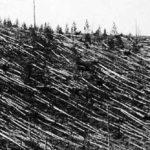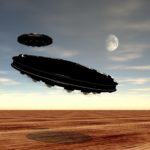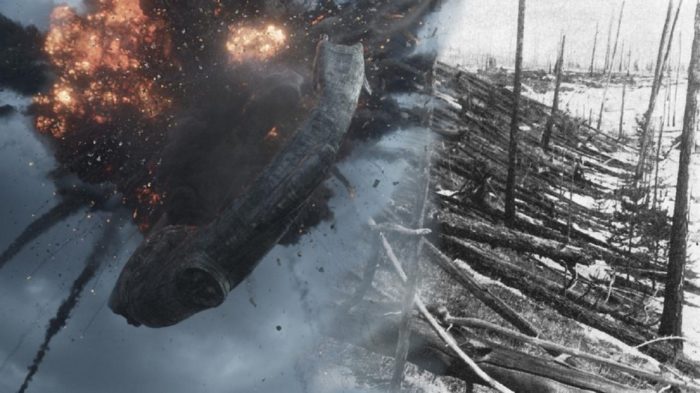
The Tunguska Incident
- By
- December 9, 2018
- September 26, 2021
- 21 min read
- Posted in
- Conspiracy Theory Analysis, Historical
When we think of “cataclysmic events” most of us will think of an event long ago in the distant past. One that perhaps shaped the world that we know today. Or some of us might think of a disastrous end-of-the-world type of scenario still to come. Perhaps in our lifetime. Hopefully not. The fact is, however, as little as slightly over a century ago, an event in the upper-most regions of Tunguska is considered by many to be as close as we in “the modern world” have come to witnessing such an event.

Artist’s impression of spaceship crashing to Earth (right), the remains of the Tunguska incident (left)
Had what many believe to be a comet or meteorite exploded a little more west and south of its location, or had it occurred just several hours later, the blast would likely have occurred near or directly over Moscow, for example. Needless to say, the loss of life would have likely been in the millions. As it happens, there are no known recorded deaths as a direct result of the incident. Of course, whether any further-reaching deaths occurred in later months and years is perhaps open to debate.
As, it would seem, is whether it was a meteor at all. Although that is the generally accepted theory, there is no solid inescapable truth to the claims. Several researchers over the decades have quietly suggested that the explosion over Tunguska was not a meteor, but of something more “nuts-and-bolts”. Possibly an alien craft. One that hadn’t purposely ventured to Earth but was in distress and ultimately exploded several miles up in the atmosphere before it could land. Or, according to some even more outlandish theories, an ancient alien defense weapon that intentionally crippled an approaching vehicle.
We will examine all of these, from the plausible to the bizarre. Just what did happen over Tunguska in 1908?
Contents
- 1 The Blast! – 7 am, 30th June, Tunguska, 1908
- 2 Midnight Light “So Brilliant One Could Read The Minutest Lettering!”
- 3 Awakened By “Whistling And Strong Winds!”
- 4 Evidence Of Several Large Explosions?
- 5 The “Bright Bluish-White Heavenly Body” Over Karelinski Two Weeks Earlier!
- 6 “Strange Underground Rattles” In-Between Artillery Fire Like “Dozens Of Trains!”
- 7 Initial Expeditions Of Leonid Kulik To The Tunguska Region
- 8 The Ideas Of Alexander Kasantsev – More Facts Hiding As Fiction?
- 9 Beyond All Doubt, Tunguska “Was A Nuclear Explosion!”
- 10 The Claims Of Felix Zigel and Alexi Zolotov
- 11 Crude Experimentation With Nuclear-Type Weapons?
- 12 Accelerated Development? Or Access To Ancient Knowledge
- 13 Connections To The Ominous “Valley Of Death” Legends?
- 14 The Strange Copper Cauldrons Of One Of The “Most Dire Regions” Of The World
- 15 “Even The Beasts Do Not Go There!”
- 16 An Advanced Defensive Alien Battle-Station? And One That Is Still Active?
- 17 The 2013 Visok Expedition
- 18 The Claims Of The Tunguska Space Phenomenon Foundation, And Yuri Lavbin
- 19 A Region Of Meteor Strikes And UFO Activity!
- 20 The Chelyabinsk Oblast Incident
- 21 Even If It Were “Just” A Meteor…?
The Blast! – 7 am, 30th June, Tunguska, 1908
Although there are no known victims of the explosion that morning at a little after 7 am on 30th June 1908, [1] those that lived nearest to the unpopulated area, the nearest being around forty miles away, could not only hear the blast and see the bright glow immediately, they could feel the intense heat also. One such farmer, Sergei Semenov, would claim that a “huge ball of fire” filled the sky. Furthermore, despite his distance, a “shock wave” from the blast knocked him clean off his feet. When he regained consciousness a short time later he would recall that the heat in the air was so hot he had to immediately go inside.
Even those who were hundreds of miles away could clearly see the “pillar of fire” in the skies as well as the “gusts of winds” that were, in fact, the shock waves from the blast. Residents in these locations would even report their windows shaking and rattling as if there was a powerful earthquake in progress. Seismic equipment as far away as the United Kingdom would register the impact. Just to demonstrate how powerful the blast was, perhaps we should consider the overall findings of the world’s scientists of the time. They would conclude that shock waves from the impact had gone around the world twice before losing momentum.
When investigators would finally manage to inspect the damage, they would find that over 770 square miles of thick forest trees had been flattened completely. Whatever the cause of the explosion was, theories, as we shall see, would suggest it occurred somewhere between three and six miles above the surface of the ground. It was the burst of air and energy that would cause the forest devastation rather than a direct impact.
Below is archive footage.
Midnight Light “So Brilliant One Could Read The Minutest Lettering!”
In the days that followed the events, the skies throughout Asia, Russia, and even as far away as Europe, remained “aglow”. Writing in the ‘Quarterly Journal of the Royal Meteorological Society’ in June 1934, F.J.W. Whipple would tell of reports from Sweden of the night in question in 1908, of the skies at night being almost as bright as the day. [2] In fact, between 30th June until 2nd July “very good photographs could be taken at midnight” such was the brightness. The report would further describe the night-time cloud over these three nights as “sometimes snow-white, sometimes golden”. Another Swedish witness would state that the light was “so brilliant one could read the minutest lettering” within its glow. Further still, a Mr. W.C. Hart from Scotland, also claimed to have captured a photograph of Dornoch Cathedral at midnight of 2nd July.
That the event was unlike anything seen by the generation of the time was certainly obvious to most. The more details and witness statements that would emerge of the incident, the more it was increasingly likely that no generations since antiquity had witnessed such an event. One that was apparently narrowly cataclysmic. In a time before the Internet, modern technology, or even satellite, and so consequently investigations and the filtering of the results of those investigations to various locations around the world would take decades. Add to this the two world wars that obviously hindered any realistic investigations into the incident. And then, following the start of the Cold War between the Soviet Union and the West for the majority of the second half of the twentieth century, any information was almost always subject to paranoid scrutiny on both sides of the Iron Curtain.
It is easy to see why areas of the incident remain murky.
Awakened By “Whistling And Strong Winds!”
While the witness statements by Sergei Semenov were key into understanding the ferocious atmosphere in the immediate aftermath of the incident, they are not the only ones. Nor indeed the earliest retrieved by investigators.
For example, I.M. Suslov would detail the account of Chuchan of the nearby Shanyagir tribe. Chuchan would state that he and his brother were asleep in their hut along the river bank when a “whistling and strong wind” woke each of them at the same time. Each of them could feel a “shove” by an invisible hand, one so hard, Chuchan “fell into the fire”. They could hear chaotic noise from outside and the two young boys became extremely scared and upset. They gathered their sleeping bags and prepared to leave their hut. Then, however, “the thunder struck. This was the first thunder”.
Suddenly “the Earth began to move and rock” and a blast of wind so strong it completely knocked over their hut. Chuchan was “pushed down (trapped)” by sticks” of the hut but he was able to see what was happening. From above him “trees were falling, the branches were on fire”. The sky was so bright it was “as if there was a second Sun”. Then, the “second thunder clap” came. Even though the morning was sunny and there was no rain falling.
While the two brothers struggled to free themselves of the remains of the ruined hut, they would continue to take in the bizarre events unfolding around them.
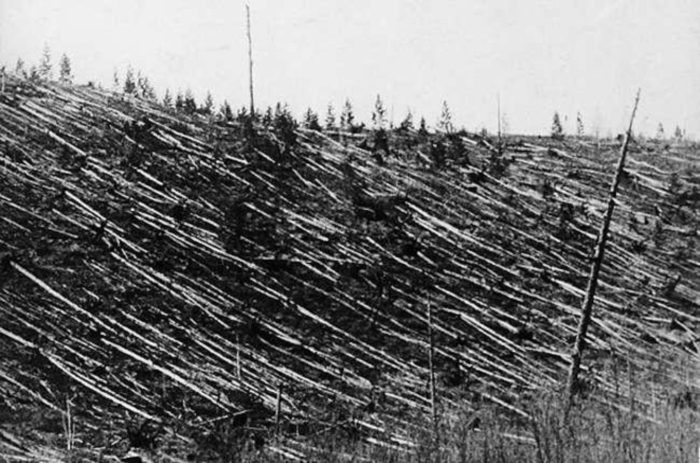
The flattened trees of the Tunguska region
Evidence Of Several Large Explosions?
After having already heard two distinct and loud “thunder claps” – loud enough to scare the two boys and physically knock them down with the wind-like aftershock – a third such boom sounded through the skies above. Just before this third thunder clap, a flash was clearly visible overhead, this time “in a different place” to the first one. A moment following the thunder, another sudden blast of wind forced them from their feet and ripped up trees as if they were blades of grass.
As they were still recovering, another flash appeared above, followed by another thunder clap, although not as loud as before. Chuchan claimed a fifth thunder strike would sound out shortly after, but this one was “somewhere far away. Where the Sun goes to sleep”.
If Chuchan’s account is genuine and accurate, then there is evidence of several different explosions taking place. Explosions that would each send powerful shockwaves out in all directions, despite their seemingly being a considerable distance away from the epicenter of the blast. While this could most certainly match a meteorite (certainly one exploding in midair) it all of a sudden opens the door to other, perhaps more outlandish, but no less intriguing and even relevant theories.
The “Bright Bluish-White Heavenly Body” Over Karelinski Two Weeks Earlier!
On the morning of the 17th June 1908, almost two weeks before the Tunguska event, according to several local newspaper reports from July of that year, strange activity was recorded near the region. According to “peasants” in the village of Karelinksi, a “bright bluish-white heavenly body”, so bright it was impossible to look at, descended downwards from above. They would describe the object as the shape of a “pipe” or a cigar. [3] It was visible for around ten minutes before it suddenly turned into strange black smoke. At roughly the same time a “knocking” sound was heard, similar to military fire.
Following this relative peaceful display, the ground and buildings suddenly shook, and strange flames and shapes appeared in the sky. Perhaps interestingly, the author of the report would state on the night in question, they too heard sounds akin to an “artillery barrage”. What’s more, there were at least ten of these “rounds” and they appeared to have regularly timed intervals. Such details would not suggest a natural phenomenon.
What does this suggest, then? Surely something more than a “natural” cosmic incident? Or might the rattle of gunfire have been a top-secret response to a meteorite? If so, it would suggest technology far ahead of what the times says was available. And it is surely unlikely that such a technology would have been in Soviet (or any country’s) hands at that point in time. What’s more, there were corroborating sightings from another nearby village.
“Strange Underground Rattles” In-Between Artillery Fire Like “Dozens Of Trains!”
Another newspaper report around the same time featured a strange sighting in the village of Kezhemskoe on the same date and time. A sudden and strange wind disturbed the residents of the village at a little before 7:45 am. [4] As soon as the wind came through, a “thump” was heard which was followed by shaking of the buildings as though they were “hit by a large log or heavy rock”. What is interesting here, is that descriptions of the event were similar to those given by Chuchan about the Tunguska event two weeks later. Residents would report that there were several “thumps” each followed by a strong wind.
However, by far the strangest detail of the events of the 17th June were reports of “strange underground rattles” in-between the thumping noises. Furthermore, these sounds were described as like a “railway upon which dozens of trains are traveling at the same time”. Even more eyebrow-raising are the claims that following these “rattles” was the distinct noise of artillery fire. Each round separated by equal intervals, just like the descriptions given by those near the village of Karelinksi.
After several minutes, the noise and winds ceased. However, in the sky towards the north, a large grey-black cloud hovered in the otherwise clear sky. By around 3 pm that afternoon, the cloud finally began to disperse.
We will return to the notion of some kind of “armed response” a little later. If the theories that prompt that return are even partially true, it could make the incidents of 17th June 1908 – thirteen days before the Tunguska incident – quietly important.
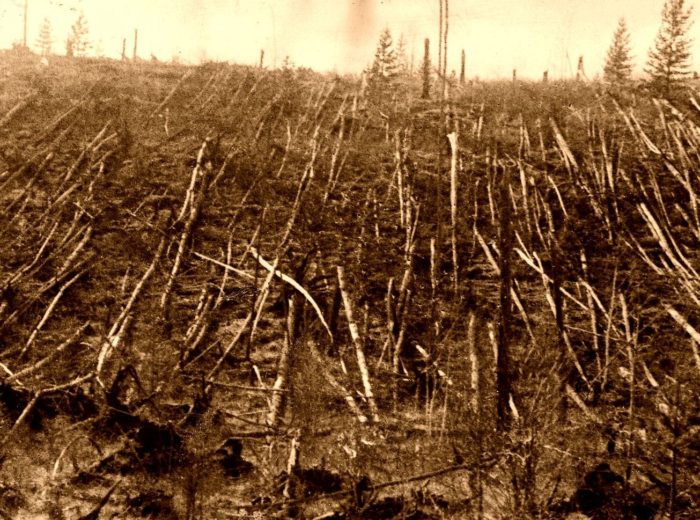
Further pictures of the tree damage
Initial Expeditions Of Leonid Kulik To The Tunguska Region
The ruin left behind following the incident was beyond extensive. Many trees were flattening. Others snapped as if they were nothing more than matchsticks. Huge chunks of earth had been thrown upwards and scattered far and wide. For a report for the Soviet Academy of Science in 1928, Leonid Kulik would write, “…the whole area bears evidence of an immense catastrophe”.
Kulik would lead the first expedition to the area in 1921, over a decade after the incident. Nevertheless, it is from his investigations that a great many of the witness testimonies come from. During his first trip to the Tunguska River region, he began to formulate his theories that a “meteorite impact” was the cause of the explosion. He would eventually succeed in persuading the Soviet authorities to fund a more extensive expedition. He claimed that he would likely discover meteoric iron, something that could aid Soviet industry immensely. Whether his claims were genuine or not, he received his desired funding. Beginning in 1927, and lasting for almost ten years, he would conduct extensive research on the incident and the area.
It was much to his surprise, then, that despite this extensive coverage of the terrain, he could find no crater or physical signs of an actual impact. He eventually had to concede that “no evidence presents itself” of a meteorite impact with the Earth. As we will see, it is largely from these findings that the widely accepted theories, still today, that a meteorite or comet entered the planet’s atmosphere that day in June 1908, but rather than impact the ground had, in fact, exploded several miles above the Earth’s surface.
The Ideas Of Alexander Kasantsev – More Facts Hiding As Fiction?
The leading, and consequently, leading theory was that a meteorite, or some other kind of cosmic body, had invaded the Earth’s airspace and subsequently exploded several miles above the planet’s surface. The energy released from this explosion would result in the devastation to a massive area of the Siberian forests. However, at the end of the Second World War, as the Americans dropped atomic bombs on the Japanese cities of Nagasaki and Hiroshima, one particular writer instantly made comparisons of the aftermath in those flattened ruins of Japan, and the chaos left behind in Tunguska.
Alexander Kasantsev would investigate the ruins of the two devastated Japanese cities. And he would become more and more convinced that what had happened over Tunguska was not a meteorite, but a nuclear explosion. When he learned that radiation levels were at increased levels for miles and miles around the region, he further believed his speculation was correct.
Kasantsev would further theorize that due to the location being so isolated that the blast was not the result of an intentional nuclear attack. [5] He would ultimately suggest that the Tunguska incident was the result of a nuts-and-bolts spacecraft, using nuclear energy as a means of propulsion, attempting to make an emergency landing but exploding in midair before reaching the ground.
What we should note here is that Kasantsev would put his theory into a fictional story rather than write it as a possible scenario for the Tunguska incident. Since then, his ideas, fictional or otherwise, have taken on a life of their own. Many, including Kasantsev according to some, believed he would face strict opposition to his ideas and so “hid” them within a fictional story. Whether he was hiding fact as fiction is open to debate.
Beyond All Doubt, Tunguska “Was A Nuclear Explosion!”
Many other researchers would follow up on Kasantsev’s ideas with a more serious frame of mind. For example, as the cities of Hiroshima and Nagasaki were researched following their absolute and total destruction, it was noted how the size of the Tunguska devastation was, roughly, thirty times that of either Hiroshima or Nagasaki. Given that we know the deadly amount of payload in each of those bombs, it would make many question whether the Tunguska episode was really “just” a meteorite. One that exploded above the ground, no less, very similar to the science behind the strikes on the unfortunate and ultimately devastated Japanese cities.
In 1966, for example, following a long and in-depth investigation, Russian scientists V.K. Zhuravlev, D.V. Demin, and L.N. Demina would all conclude, beyond any reasonable doubt according to their findings, that the incident over Tunguska in June 1908 was most definitely a nuclear explosion.
Furthermore, they weren’t on their own in their seemingly off-the-mark conclusions.
At around the same time as the Zhuravlev, Demin, Demina investigation and ultimate findings and Russian professor, and a Russian geologist were undertaking their own research. What’s more, although many are dubious, at best, of their findings and investigation, their argument is intriguing at the very least.
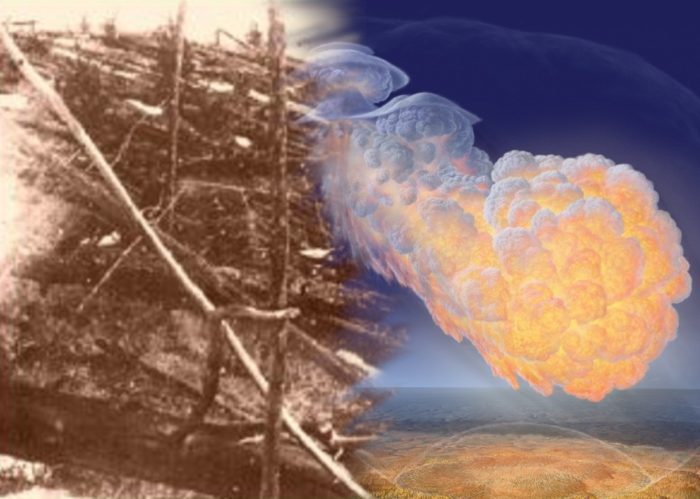
Artist’s impression of a fireball exploding over Tunguska (right)
The Claims Of Felix Zigel and Alexi Zolotov
Professor Felix Zigel and geologist, Alexi Zolotov would venture out to the apparent “blast zone”. [6] What’s more, their research this area was more or less in the shape of an oval. Furthermore, Zolotov would discover a strange metallic presence in the soil within this blast zone. Ultimately, this would lead Zolotov to suggest that the “explosive material” was encased inside a “non-explosive” shell when it exploded. That was, he would argue, because the material was of a nuclear-type and was likely the propulsion system of what was an alien space craft.
Even more intriguing, Zigel would speak to several surviving witnesses. Some of these would state their clear recollections of a “fireball” changing direction several times on the morning of the explosion. If such claims are accurate, it certainly isn’t the behavior of a comet or a meteorite. Interestingly or not, Zigel would also obtain a report from the Tatranska Observatory in Poland. It would state that in the early hours of 30th June 1908, only an hour or two before the Tunguska incident, they would track a “fireball” falling from the sky. However, rather than merely fall to the ground or burning up, this strange anomaly would change direction on several occasions.
Zigel and Zolotov would also point to the state of the trees in the area, particularly those in the perceived epicenter of the blast. They would note how only the side of the tree that faces “inwards”, or towards the apparent blast zone, had burn or scorch marks. This is consistent with a sudden and intense surge of heat. This is exactly what happens in a nuclear-type explosion.
Ultimately, their conclusion was that an “artificial construction”, likely an extraterrestrial vehicle, was “being directed towards a landing when it exploded”.
Crude Experimentation With Nuclear-Type Weapons?
We will return to the apparent mysterious detail of “underground rattles” and artillery fire in a moment. One of the theories as to just what this might have been, while possibly unlikely, is mind-bendingly fascinating.
We have examined before the idea that nuclear and advanced weapons existed in the distant past. In fact, the evidence to support such claims is in more abundance than most mainstream historians would have us believe. However, in contemporary times, history tells us such weapons were not available until the 1940s. Maybe we should remember the words of Robert Oppenheimer, the so-called “Father of the Atom Bomb” who when asked if a recent test at the Alamagordo base was, in fact, the first nuclear blast would reply “Yes! In modern times”. What Oppenheimer was clearly saying was such predetermined blasts had taken place in antiquity.
Many ancient Sanskrit writing, for example, speak of such blasts, whose descriptions almost identically match the aftermath of nuclear blasts of the twentieth century. Many of these texts were discovered, relatively speaking, in same region “East” region of the world. While we know the Nazis had a particular interest in these ancient writings, even sending teams to recover them in the years leading up to the Second World War, perhaps the Russians or another mysterious group of “rich investors” made earlier discoveries.
Accelerated Development? Or Access To Ancient Knowledge
Might it be, however unlikely and speculative as the idea is, that the incidents leading up to Tunguska, and even Tunguska itself, was a secret and crude experiment with early nuclear-style weapons? What else could artillery fire and “regular intervals” be but the purposeful discharge of weaponry? And if so, were these theoretical events “just” weapons testing? Or might there have been a legitimate target to aim for?
Might there indeed have been some kind of unidentified aerial presence over the skies of Siberia in the weeks leading up to the Tunguska incident? And might this presence have been met with such brutal and, to the vast majority of the world’s population, weapons unknown to them? Even if this admittedly unlikely scenario was accurate, where did the knowledge, and even the need for such weapons, in 1908 stem from?
Perhaps, as we will look at in a moment, the military, or whoever might have been utilizing such potential nuclear weaponry, didn’t develop it of their own accord. Or discover ancient knowledge and instructions on how to do so. Perhaps they discovered the physical remains of ancient and long-lost weapons. It is certainly possible that such a discovery took place deep in the forests of Siberia. A discovery that many tradespeople and nomadic tribes had known about for hundreds of years. And one from a region with a long history of mysterious activity and encounters.
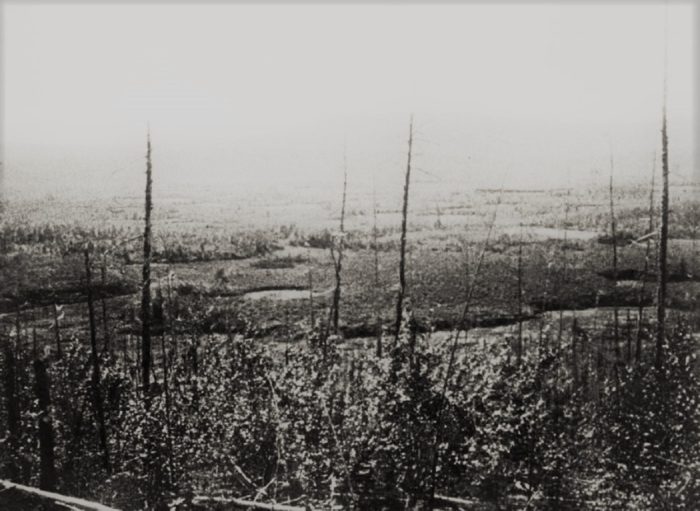
View of the wider Tunguska region
Connections To The Ominous “Valley Of Death” Legends?
In the surrounding areas of northwestern Yakutia in Siberia near the Tunguska region, is an ominous stretch of land by the name of Uliuiui Cherkechek. Or, when translated, “The Valley of Death”. [7] What’s more, this dark region has a long history of equally dark legends stretching back almost a thousand years. In fact, so entrenched in the local population are the legends of the Valley of Death, that they rarely venture there. And don’t advise the various visitors they get each year that they should either.
According to these legends, the dense forest region was home to an intense battle between two powerful enemies. These most remarkable events go back to around the late-thirteenth or early-fourteenth century. One of the attacks would come from above (from the air), while the other would hurl “balls of fire” from the ground. This is a remarkable detail. Is it some kind allegory for a meteor strike around the early 1300s? There is little geological evidence of such a strike. Or should we take the legend more directly? Is it describing an advanced aerial attack on a facility somewhere on the ground, which then responded with equally advanced weaponry which sound similar to artillery fire?
Remember, the claims around the sightings several weeks before the Tunguska incident mentioned exactly this type of sound. They also mentioned an “underground rattle”. When we further examine some of the remains of the area, these claims also begin, theoretically, to make more sense.
The Strange Copper Cauldrons Of One Of The “Most Dire Regions” Of The World
While the legends have seemingly been around, orally at least, for around 800 years, an expedition from the mid-1850s provides us with some of the most intriguing finds of the area. The explorer, known only as “R. Maak” would discover “gigantic cauldrons made of copper”. However, “only the rim” was visible above the ground. The rest, it would seem, was deep below the earth.
The area itself runs from Bodaibo to Annybar and right the way through to the Laptev Sea. According to histories of ancient times of the area, it was once part of a nomadic trading route. In fact, right up until 1936 there is an account of a trader along this route, Savvinov and his granddaughter, Zina. One night on their way home, they found one of these “reddish arched” buildings and with night drawing in, decided to stay the night. Savvinov, who had stayed in these strange buildings in similar situations before, led Zina “beyond a spiral passageway” and into a “metal chamber”. He told her that “even in the harshest frosts it was as warm as summer in the chambers”.
There are several more “local legends” dating back to the 1930s of both legal and illegal traders of various produce and items in this sparsely populated area. Most revolve around such traders stumbling across these mystery dome-like structures and, given the brutal winter conditions at certain times of year using them as a temporary shelter. However, many of them would soon become intensely ill with nausea and dizziness. So much so, it was often preferable to go back out into the elements rather than sit within these menacing cauldrons.
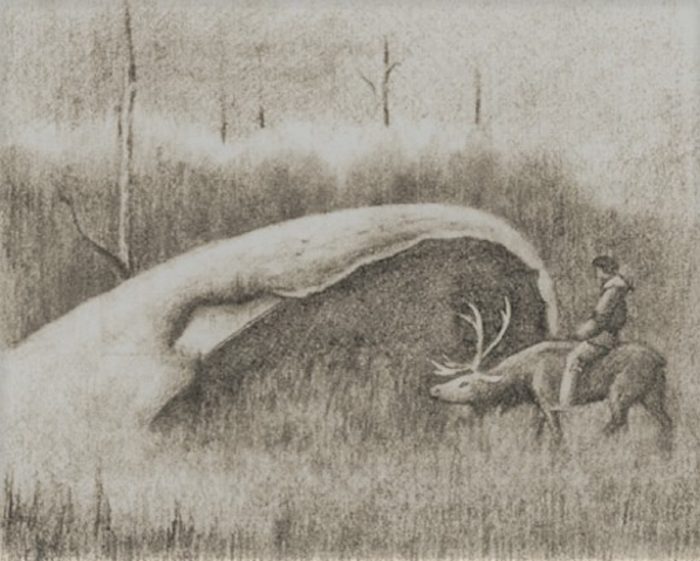
Sketch of the strange Cauldrons in the Tunguska region
“Even The Beasts Do Not Go There!”
As the legends of the ill-health inducing cursed copper houses of the deep forests of Siberia took on more and more momentum, many serious-minded but equally intrigued scientists, explorers, and geologists would set out to discover and ultimately rationalize these mysterious structures for themselves. Indeed, to such serious and trained minds, these “cauldrons” were simply a mix of unknown history and local folklore of the bootlegging world of the black market and the discreet trading routes they coveted for themselves.
In 1936, one such geologist would venture into the wilderness of the Valley of Death to do just that. He would take with him an elderly and “wise” native of the area. Along the Olguidakh River, he and the elder would discover just such a structure. Incidentally, according to some researchers, the word Olguidakh translates to “place with a cauldron”.
The unnamed geologist would describe the ruined remains in his report as a “smooth metal hemisphere, reddish in color”. Furthermore, the edges of this structure were so sharp and precise that you could “cut a fingernail” on them. Even more remarkable, these dome-like remains, despite at least half of their structures having sunk underground, had such a large entry into them, that a person could “ride a reindeer under it”. Indeed, a sketch from the expedition shows one of the team doing just that. You can view the sketch above. It is an accurate representation of how these cauldrons would have looked while still visible and above the ground.
They would stay one night in this apparent ancient ruin. However, they were more than familiar with the tales of traders dying suddenly if they stayed too long. Local legend tells all “even the beasts do not go there”.
An Advanced Defensive Alien Battle-Station? And One That Is Still Active?
So, what is the connection between these mysterious structures in the forests of Siberia? Named rather ominously the “Valley of Death”, to boot. According to some claims, particularly the local battle legends, these structures are ancient defensive weapons against aerial invaders. And what’s more, these still active weapons came into action on the morning of 30th June 1908, most likely through nothing more than predetermined programming to do so and turned its attention to whatever came hurtling out of the skies over Tunguska.
It is a bizarre and truly outlandish theory, no doubt. But might there be more truth to the notion that an ancient, yet highly-advanced surface-to-air laser-type defense weapon exists deep in the uninhabitable area of Siberia? A weapon that might have somehow played a part in the still mysterious events over Tunguska over 100 years ago? While such speculation will undoubtedly be dismissed without even the slightest glance by most, there is more weight to it than mere fantasy. Even if it ultimately does turn out to be incorrect.
For example, are these cauldrons responsible for the “balls of fire” of the legendary battle that took place here hundreds of years ago? If so, who are these differnt sides? Are they both “aliens”, or might one be a human settlement, albeit with technology for in advance of what history says they should have had? Does this also explain the apparent rife levels of radiation in the area? Are they so high due to the presence of such powerful weapons? Perhaps above all else, are the remains of these cauldrons still visible today?
Before we delve into that, though, check out the video below. It looks at these suggestions advanced ancient weapons a little further.
The 2013 Visok Expedition
Michale Visok had a long fascination with the legends of the Valley of Death. [8] And what’s more, his initial research in 2013 had identified several strange “circular” patches in the otherwise grim terrain. To obtain an even better view of the area, his team would arrive at the destination using specifically designed parachute-copters. As they drifted over the area, they could target their landings precisely. As well as gain a literal bird’s eye view of the land below. There were indeed several circular areas that looked very promising. They would take their parachute-copters down to the marshy land and begin investigating.
It wasn’t long before they would locate a metallic “anomaly” just a little below the thick swampy waters. They had been in the area for several hours by the time of this apparent breakthrough discovery. The task now was to investigate the object more close-up. And confirm if it was indeed one the legendary “copper cauldrons”. However, within hours of this discovery, Viosk would become suddenly violently ill. He would suffer from extreme nausea and dizziness. Although he wished to stay, the weather was also threatening to take a turn for the worse. They would ultimately decide to vacate the area with a view to returning in the near future.
Incidentally, Viosk would receive an immediate medical check-up upon returning from the expedition. Bizarrely, the doctors could find absolutely nothing wrong with him. He would make a full recovery within hours of leaving the marshy swamplands of the Valley of Death. That he would suffer from the exact same symptoms as the legends assured him is surely more than mere coincidence.
The short video below looks at Viosk’s excursion a little further.
The Claims Of The Tunguska Space Phenomenon Foundation, And Yuri Lavbin
Throughout the 2000s, several theories surfaced, allegedly with “new evidence” as to what happened at Tunguska almost a century earlier. Two particular claims stand out a little more than most of this era. The first, in 2004, would come following an expedition by the Tunguska Space Phenomenon foundation. They would claim to have uncovered “blocks of an extraterrestrial technical device” from the Tunguska region. They would present a small piece of this for analysis at a laboratory in Krasnoyarsk.
The claims made in 2004 would cause a small ripple in the UFO community. Claims five years later by researcher Yuri Lavbin, however, were a little more explosive. He would ultimately claim in 2009, following his own expedition to the area, that a UFO had intentionally collided with an approaching meteor in order to literally “protect our planet from devastation”. Needless to say, many would reject his claims in their entirety.
To support his claims, he would produce ten quartz crystals from the crash site. Furthermore, several of these crystals have strange and precise holes in them so they might be linked. Even stranger, “strange drawings” are present on several of them. Lavbin would claim that we don’t have any “technologies that print such kind of drawings on crystals”. Using the most sophisticated laser machine available, engineers would attempt to replicate the drawings and symbols. However, despite the laser being able to cut through metal, it would barely make a mark on the crystals. Stranger still, and perhaps most intriguing, were the claims of finding “ferrum silicate” – something only found in space.
Lavbin believes these strange quartz crystals were likely part of some advanced space map. This would make a certain amount of sense given what we now know of the memory storing capabilities of crystals.
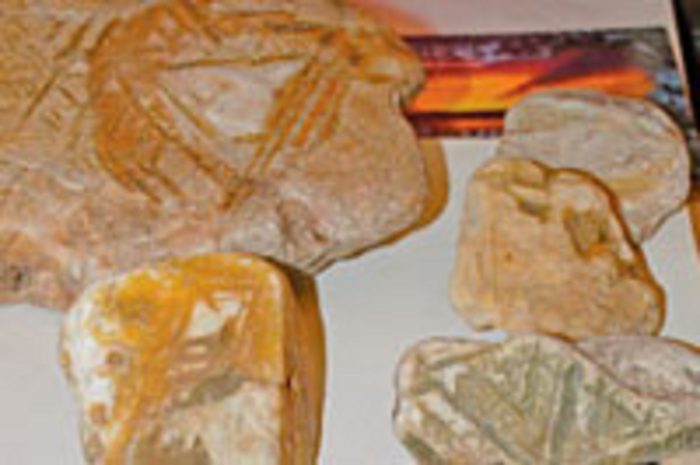
Are these the remains of a craft from outer space?
A Region Of Meteor Strikes And UFO Activity!
We shouldn’t dismiss such claims of an alien craft exploding on Earth while attempting to make an emergency landing. We should also note, however, that several similar, if less devastating impacts have occurred in the region since. As well as Russia in general. And midair explosions of meteorites have occurred on several other occasions. Albeit with less devastating consequences.
For example, in February 1947, a large iron meteorite fell to Earth in the Sikhote-Alin Mountains. [9] It is the largest such iron meteorite on record. In total over 70 metric tons of iron surviving its entry into the atmosphere.
Although it took place on the other side of the world over the Curuca River in Brazil, [10] an incident in 1930 is thought to have been another case where a meteor, after exploding in midair, left no evidence of an impact crater at all. In fact, only through modern testing techniques was there confirmation of this event. Until then, it was merely the result of witness statements after the event. And even then, only because of the actions of a Franciscan monk, Fedele d’Alviano. He would take it upon himself to travel to the region and investigate the claims for himself in 1931.
In short, this type of activity, certainly before the Internet, could have happened often in remote parts of the world. Very likely more than we think. And simply gone unreported and, in turn, unnoticed. However, in the modern age, these types of events will almost always be noticed. Just like an incident in February 2013 would prove.
The Chelyabinsk Oblast Incident
In more recent times, in the Ural Mountain near the region of Chelyabinsk Oblast, an asteroid entered the Earth’s atmosphere and was witnessed by hundreds of people screaming across the morning skies of 15th February 2013. [11] The light from the object was even brighter than the rising sun. So much so that people over sixty miles away could see it clearly. Furthermore, particular for those in the region of Chelyabinsk Oblast, a feeling of “intense heat” would accompany the brilliant sighting. The object would ultimately explode around 18 miles above the Earth’s surface. This explosion would result in an even brighter flash and a hot dust-cloud with a radius of over 15 miles. The energy released was around thirty times that of the Hiroshima atomic explosion following World War Two.
The shock waves from the explosion would result in injuries to over 1,500 people. Most of the injuries were the result of cuts from the broken glass of blown-in windows which would shatter instantly. Just to get an appreciation of the damage of this otherwise “minor” incident, over 7,000 buildings across six cities would suffer significant damage as a result of the blast.
Maybe the most concerning thing was the detection of the object only came after it entered the Earth’s atmosphere.
Perhaps, though, we should also note the long history of apparent UFO sightings in pre-Soviet-Russia, stretching back hundreds of years. There is no doubt that most meteorite incidents are exactly that and nothing more. There is also a rich history of UFO activity in the less-populated regions of northern Russia and the Siberia region.
Before we move on, you check out footage of the Chelyabinsk incident below.
Even If It Were “Just” A Meteor…?
So, is there any credence to the claims and speculative theories that the incident over Tunguska in the summer of 1908 was really one of an extraterrestrial nuts-and-bolts craft? One that possibly destroyed an incoming meteor? Either with an advanced weapon or simply by crashing into it and taking the impact in place of the ground? Or might this nuts-and-bolts craft have been destroyed by an ancient advanced technology? Possibly extraterrestrial in nature, that has remained hidden in the region referred to as the Valley of Death? Maybe this visiting craft was here through circumstance? Themselves in a dire situation that would result in the accidental explosion of their craft several miles above the Earth?
All of these are outlandish, of that there is no doubt. And while some are more so than others, the fact is that while the explanation of a meteor exploding above the surface of the Earth rather than simply impacting it as we might expect it to is perhaps the most reasonable, it remains, just a theory. The fact is there is still so much uncertainty around the apparent “sensible” and “reasonable” explanation. And an equal amount of historic mystique around the entire region in general. This surely keeps these speculative theories just as relevant.
The fact is, we’ll likely never know what the events of 30th June 1908 around 7:17 am were. Let’s say, for example, it was “just” a meteor. That in itself is a scary enough notion. And one that should make all of us sit up and think, this could happen again, at any moment. And without adequate warning. Whereas many are quick to criticize space research, perhaps it is an area we need to consistently fund? For reasons that most of us don’t always see.
References
| ↑1 | The Tunguska event: a Siberian meteor mystery from 1908, Lauren Niland, The Guardian, February 8th, 2013 https://www.theguardian.com/theguardian/from-the-archive-blog/2013/feb/08/tunguska-asteroid-comet-1908-siberia |
|---|---|
| ↑2 | On Phenomena related to the great Siberian meteor, F.J. W. Whipple, October 1934 https://rmets.onlinelibrary.wiley.com/doi/abs/10.1002/qj.49706025709 |
| ↑3 | Tunguska Event, Crystal Links https://www.crystalinks.com/tunguskaevent.html |
| ↑4 | Tunguska-Tesla Theory: Did Tesla Cause the Tunguska Explosion?, Exemplore, June 26th, 2020 https://exemplore.com/paranormal/Nikola-Tesla-and-the-Invention-of-the-Death-Ray-Machine |
| ↑5 | Researchers say Tunguska Event was an UFO Crash: Debris of Alien Spaceship found, Physorg, August 10th, 2004 https://phys.org/news/2004-08-tunguska-event-ufo-debris-alien.html |
| ↑6 | Nuclear Tunguska, Doug Yurchey, The Mystica https://www.themystica.com/Nuclear-Tunguska/ |
| ↑7 | Siberian UFO Underground Base, Rich Hansen, Info Quest http://info-quest.org/documents/SiberianUfoBase.html |
| ↑8 | Mysterious Cauldrons in Siberian Valley of Death Still Unsolved, Paul Seaburn, Mysterious Universe, October 25th, 2016 https://mysteriousuniverse.org/2016/10/mysterious-cauldrons-in-siberian-valley-of-death-still-unsolved/ |
| ↑9 | Meteoritical Bulletin Database https://www.lpi.usra.edu/meteor/metbull.php?code=23593 |
| ↑10 | The Event Near The Curuca River, 2004 https://www.lpi.usra.edu/meetings/metsoc2004/pdf/5150.pdf |
| ↑11 | Meteorite hits central Russia, more than 500 people hurt, Natalia Shurmina and Andrey Kuzmin, Reuters, February 15th, 2013 https://www.reuters.com/article/uk-russia-meteorite/meteorite-hits-central-russia-more-than-500-people-hurt-idUSLNE91E00G20130215 |
Fact Checking/Disclaimer
The stories, accounts, and discussions in this article may go against currently accepted science and common beliefs. The details included in the article are based on the reports, accounts and documentation available as provided by witnesses and publications - sources/references are published above.
We do not aim to prove nor disprove any of the theories, cases, or reports. You should read this article with an open mind and come to a conclusion yourself. Our motto always is, "you make up your own mind". Read more about how we fact-check content here.
Copyright & Republishing Policy
The entire article and the contents within are published by, wholly-owned and copyright of UFO Insight. The author does not own the rights to this content.
You may republish short quotes from this article with a reference back to the original UFO Insight article here as the source. You may not republish the article in its entirety.
